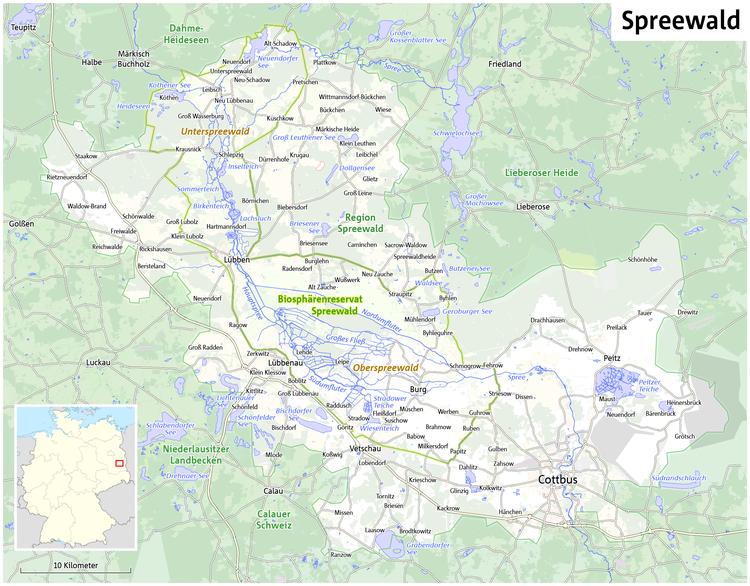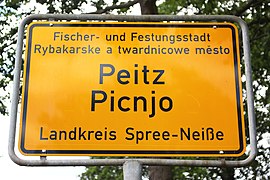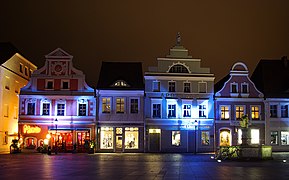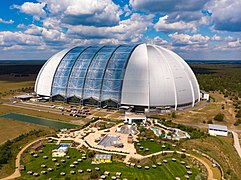This article has multiple issues. Please help improve it or discuss these issues on the talk page. (Learn how and when to remove these messages)
|
| Spree Forest Spreewald Błota | |
|---|---|
 The Spree Forest Biosphere Reserve The Spree Forest Biosphere Reserve | |
| Location | Brandenburg |
| Coordinates | 51°54′50″N 13°55′35″E / 51.91389°N 13.92639°E / 51.91389; 13.92639 |
| Designated | Biosphere reserve |
| Website | Official website |
The Spree Forest or Spreewald (German pronunciation: [ˈʃpʁeːˌvalt] ; Lower Sorbian: Błota, i.e. 'the Swamps') is a large inland delta of the river Spree, and a historical cultural landscape located in the region of (Lower) Lusatia, in the state of Brandenburg, Germany, about 100 km southeast of Berlin and close to the city of Cottbus (L.S. Chóśebuz). The Spree Forest is located within the settlement area of the (Lower) Sorbs, and the region is officially bilingual, German and Lower Sorbian.
As extensive floodplain and bog landscape, the Spree Forest was designated a biosphere reserve by UNESCO in 1991, called Biosphärenreservat Spreewald (biosferowy rezerwat Błota). It is known for its traditional irrigation system, consisting of more than 200 small canals (called Fließe; total length: 1,300 kilometres or 810 miles) within the 484-square-kilometre (187 sq mi) area, for its unique flora and fauna, and for its traditional flat-bottomed boats, the Spreewaldkähne. The landscape was shaped during the last Ice Age.
The region's most populous towns are Lübbenau/Spreewald (L.S. Lubnjow/Błota), which is known for the incorporated villages of Lehde (Lědy) and Leipe (Lipje), the villages with canals instead of streets, and Lübben (Spreewald) (Lubin (Błota)). Other notable towns are Vetschau/Spreewald (Wětošow/Błota) with its reconstructed Old Slavic fortified wooden settlement (gord) Slawenburg Raddusch (Radušańske słowjańske groźišćo), and Burg (Spreewald) (Bórkowy (Błota)).
Overview



Slawenburg Raddusch
Radušańske słowjańske groźišćo
at Vetschau-Raddusch
About 50,000 people live in the biosphere reserve (1998). Many of them are descendants of the first settlers in the Spree Forest region, the Slavic tribes of the Sorbs and Wends. They have preserved their traditional language, customs and clothing to this day.
Most inhabitants depend on tourism. Many tourists explore the Spree Forest in punts. Agriculture, forestry and fishery are other important sources of income. The principal town of the area is Lübbenau.
The Spree Forest gave its name to the following German districts:
Landscape and nature
Alder forests on wetlands and pine forests on sandy dry areas are characteristic of the Spree Forest region. Grasslands and fields can be found as well. About 18,000 species of flora and fauna have been identified. In 1991, the Spree Forest was designated a UNESCO "Biosphärenreservat" (Man and Biosphere Reserve Programme).
Economy
The Spree Forest is a tourist destination, and a centre of production of natural organic products. The tourism and economic demarcation of the Spree Forest is thus much more difficult than its geographical extension. Due to its popularity and the associated advantage, the borders of the Spree Forest tourism and business area have increasingly extended beyond the original bounds of the Spree Forest. This is particularly true of the regional food industry, as the Spree Forest economic area created for this industry (famed in Germany for the Spreewald gherkin and other pickles) is much larger than the ecological Spree Forest. This economic area is protected by the Protected Geographical Indication scheme of the EU. Before the legal protection of the space there were several court disputes over the designation Spree Forest on food labels.
Map

Gallery
-
 Spring in the Spree Forest (Lübbenau-Lehde/Lubnjow-Lědy)
Spring in the Spree Forest (Lübbenau-Lehde/Lubnjow-Lědy)
-
 Beer garden in Lübbenau
Beer garden in Lübbenau
-
 Fishermen and fortification city of Peitz
Fishermen and fortification city of Peitz
-
 1900 Spree Forest postcard
1900 Spree Forest postcard
-
 Neuendorfer See seen from Neuendorf am See (Nowa Wjas pśi jazoru)
Neuendorfer See seen from Neuendorf am See (Nowa Wjas pśi jazoru)
-
 Tourism in the Spree Forest: 1902 postcard "Neckerei" (teasing)
Tourism in the Spree Forest: 1902 postcard "Neckerei" (teasing)
-
 Greifenhainer Fließ (Greifenhain Canal) at Kolkwitz-Babow (Gołkojce-Bobow)
Greifenhainer Fließ (Greifenhain Canal) at Kolkwitz-Babow (Gołkojce-Bobow)
-
 Gasthaus "Zum fröhlichen Hecht" (Inn "To the happy pike") in Lübbenau-Lehde
Gasthaus "Zum fröhlichen Hecht" (Inn "To the happy pike") in Lübbenau-Lehde
-
 Autumn in the Spree Forest (Burg (Spreewald)/Bórkowy (Błota))
Autumn in the Spree Forest (Burg (Spreewald)/Bórkowy (Błota))
-
 Slavic gord Raddusch in Vetschau-Raddusch (Wětošow-Raduš)
Slavic gord Raddusch in Vetschau-Raddusch (Wětošow-Raduš)
-
 Cottbus (Chóśebuz), largest city in the region
Cottbus (Chóśebuz), largest city in the region
-
 Cottbus Old Market Square (Altmarkt/Stare Wiki)
Cottbus Old Market Square (Altmarkt/Stare Wiki)
-
 Cottbus Christmas Market
Cottbus Christmas Market
-
 The Tropical Islands Resort is partly located within the municipal boundaries of Krausnick-Groß Wasserburg (Kšušwica-Wódowy Grod), Amt Unterspreewald (Dolne Błota)
The Tropical Islands Resort is partly located within the municipal boundaries of Krausnick-Groß Wasserburg (Kšušwica-Wódowy Grod), Amt Unterspreewald (Dolne Błota)
See also
External links
- Official Website
- "Spreewald" . Encyclopædia Britannica. Vol. 25 (11th ed.). 1911.
- The Spreewald Guide - your Guide for the Spreewald area
- Information about country, people and tourism in the Spreewald in English
- Cycling-trip through the Spreewald – with many Pictures
References
- Aladesuyi, Oluwakemi (2016-10-04). "Globalization: A Pickle's Tale". The Atlantic. Retrieved 2019-06-29.
| Biosphere reserves in Germany | ||
|---|---|---|
